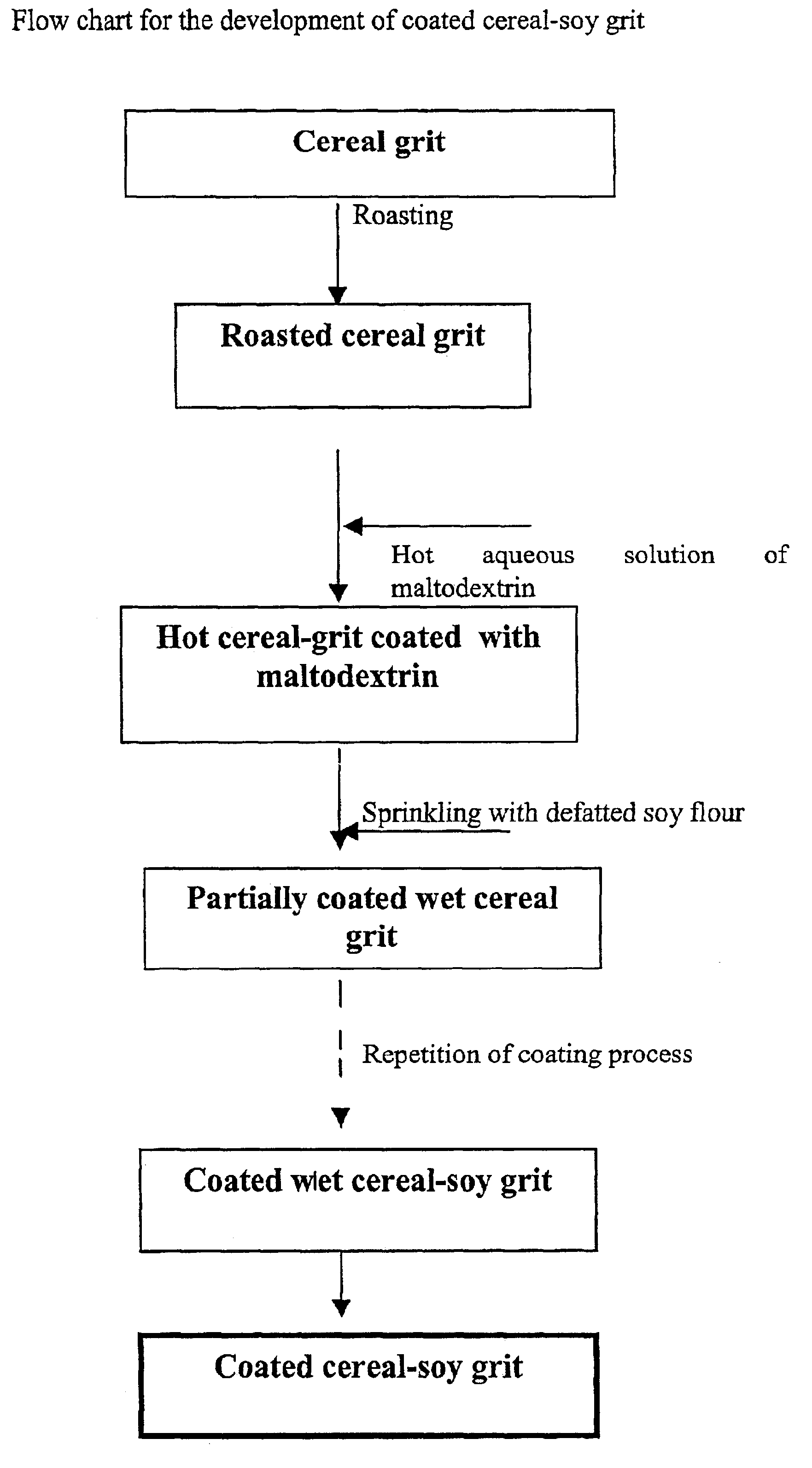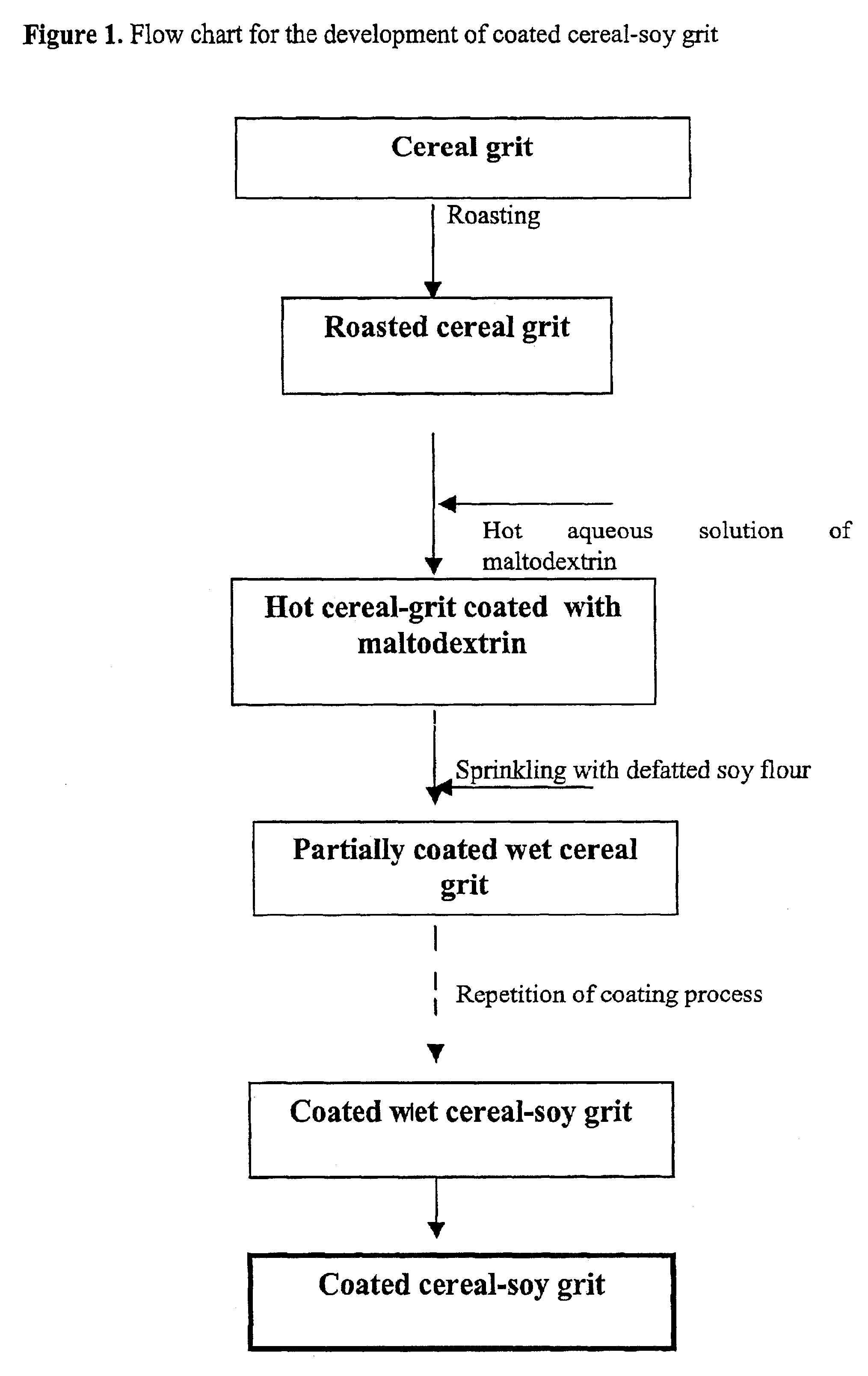Cereal grit food product having enhanced shelflife and high protein content
a technology of high protein content and food product, which is applied in the field of enhanced shelflife and high protein content of cereal grit food products, can solve the problems of reducing shelf life, increasing product cost, and high oil content of product, and achieves enhanced shelf life with taste and appearance
- Summary
- Abstract
- Description
- Claims
- Application Information
AI Technical Summary
Benefits of technology
Problems solved by technology
Method used
Image
Examples
example 1
50 kg of corn grit (average particle is size 316 micron) with a moisture and protein content of 7.5% and 8.2%, respectively, passing through a 18 mesh (British standard sieve), was roasted in a rotary coffee roaster for 1 hour. The end point of roasting was selected when the material attains a temperature of 120° C. at which time it was allowed to get roasted for another 10 minutes. 2.63 kg of maltodextrin was dispersed in 4.30 liters of warm (about 60° C.) water by stirring gently to make the coating-cum-binding suspension. 25 kg of hot roasted corn grits were placed in a ribbon mixer and the coating suspension was poured and defatted soyflour (5.26 Kg) were sprinkled alternatively in three stages to get the partially wet corn-soy grits which were later dried in a tray drier at 65° C. for 1 hour. The commercially obtained untoasted defatted soya flour had a protein content of 49.5% and a moisture content of 6.3%. The average particle size of defatted soya flour, as determined by us...
example 2
5 kg of coarse wheat semolina with a moisture and protein content of 8.3% and 10.3%, respectively, passing through a 18 mesh (British standard sieve) but retained on 24 mesh sieve, was roasted in a rotary coffee roaster for 45 minutes. When the material was about 100° C., it was roasted for another 5 minutes at that temperature. 275 g of maltodextrin was dispersed in 450 ml of warm (about 70° C.) water by stirring gently to make the coating-cum-binding suspension. The hot roasted corn grits were then coated with the above mentioned maltodextrin suspension and 1 kg of toasted defatted soyflour, as mentioned in example 1. The coated grits which were later dried in a tray drier at 65° C. for 1 hour. The developed soycoated wheat grit / semolina had moisture content of 5.8%.
example 3
The corn-soy grits, developed by following the method as described in example 1, was used to prepare different sweets, such as, soji or kesari bath or halwa and rawa laddu (sweet dishes) as described in the following lines. 250 ml of water was boiled in which 100 g of the said corn-soy grit was poured and cooked for another 3 minutes while adding 200 g of powdered sugar and 75 g of hydrogenated fat 1 minute before the end of cooking. Mixing was continued for 2 minutes when a semi-solid viscous mass was obtained with the indication for oil separation, i.e., and no further oil was absorbed. The whole mass was allowed to cool for 5 minutes and served warm. The finished product had an attractive bright yellow colour.
Rava laddu (sweet spherical balls made using the corn-soy grits) was also prepared as described in the following lines. Well known food products prepared from chickpea flour include boondi (spherical shaped deep-fat fried product made from the batter) and laddu. The latter i...
PUM
 Login to View More
Login to View More Abstract
Description
Claims
Application Information
 Login to View More
Login to View More - R&D
- Intellectual Property
- Life Sciences
- Materials
- Tech Scout
- Unparalleled Data Quality
- Higher Quality Content
- 60% Fewer Hallucinations
Browse by: Latest US Patents, China's latest patents, Technical Efficacy Thesaurus, Application Domain, Technology Topic, Popular Technical Reports.
© 2025 PatSnap. All rights reserved.Legal|Privacy policy|Modern Slavery Act Transparency Statement|Sitemap|About US| Contact US: help@patsnap.com



